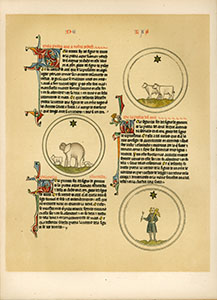
Animals in Jewish, Christian, and Islamic Illustrations from the Middle Ages

Lapidario del rey D. Alfonso X: codice original, Facsimile of Biblioteca de El Escorial, MS. h.I.15 (1279 CE)
1881. Madrid: Impr. de la Iberia, á cargo de J. Blasco
12.5 in. x 9 in.
096.1L313
Rare Books Collection, Special & Area Studies Collections, George A. Smathers Libraries
The Lapidario del rey D. Alfonso X was a translation of an Arabic text commissioned in the 13th century by Alfonso the Wise, the King of Castile. Lapidaries were works devoted to explaining the qualities and properties of gems; they were extremely popular in the Middle Ages when it was believed that gemstones comprised manifold medical and magical powers. Alfonso’s Lapidario explores the relationship between gemstones and the Signs of the Zodiac.
The Lapidario manuscript is richly illustrated: animals representing the Signs of the Zodiac appear in miniatures and
hybrid beasts illuminate the borders throughout. However, on a page dealing with the Sign of Pisces and under a description dedicated to a stone called “Zebech” (black onyx), we find a strange image of an elephant with a black-colored human head. It is possible that this hybrid beast conveys a disturbing message, an undertone of early prejudice in the depiction of an animal-like African man. Yet the notion of prejudice seems odd given the multicultural milieu in which this translation was produced. Cosmopolitan in his outlook and committed to bringing Spain out of the Dark Ages, Alfonso invited Jewish, Muslim and Christian scholars to occupy prominent positions in his Court; many were engaged in translating historical, religious and scientific books from Arabic and Hebrew into Latin and Castilian, and it was a Jewish scholar, astronomer and physician, Yehudah ben Moshe ha-Kohen, who produced this particular work.